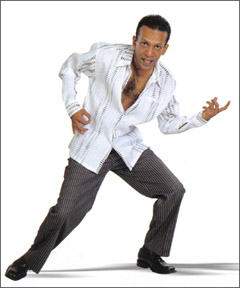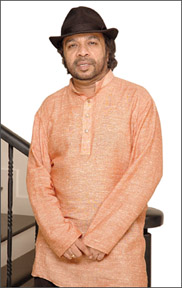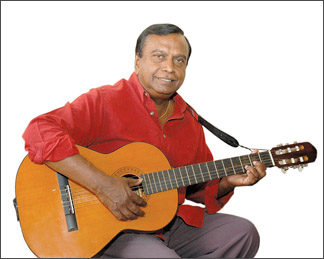They keep the 70's Sinhala pop alive
by Prasad Gunewardene
|

Rajiv Sebastian |
Calypso and Sinhala pop music has a long history. Calypso, they say
was blended into Sinhala style in the early 1960s by musicians like Noel
Ranasinghe, Neville Fernando and a few others.
The Sinhala pop style of course came in the mid 1950's when men like
CT Fernando, Vincent de Paul Peiris, Sydney Attygalle, Maurice
Dahanayake and Christopher Paul changed the melodies of several English
hits from the slow waltz type into six eight style.
But, the real Sinhala pop music came with the emergence of the
electric guitar introduced by the legend, Clarence Wijewardene. Clarence
introduced a new style with original Sinhala pop melodies.
The introduction of Sinhala pop in a startling fashion that captured
audience by Clarence was then hated by the classical types who began to
lose ground. Attempts were made to shut the doors at the then Radio
Ceylon to pop style musicians. Sinhala pop was like poison to the
classical and oriental musicians.
There was then the 'Coreas' at the Radio Ceylon in charge of English
Programmes like 'Saturday Stars' and the 'Sooriya Show'. The two men
were Vernon and Vijaya Corea.
|

Sunil Perera |
They came forward to help people like Clarence Wijewardene and the
emerging stars of the calibre of Neville Fernando, Annesley Malawana,
Roy Fonseka, Noel Ranasinghe, Priya Peiris, Joe B. Perera, Meril
Fernando, Maxwell Mendis, Dharmaratne Brothers, Paul Fernando and
Mariazelle Gunetilleke. The Coreas were a blessing in disguise to these
musicians of the day.
The Sinhala Calypso and Pop Groups of the late 1960's and 70's came a
long way thanks to the Coreas. In a hard fought battle, these musicians
later managed get a fifteen minute daily programme over the state radio
for 'Group Songs'. After some time, due to unknown reasons it was
scrapped.
Day by day, the pop style became popular. If there were musical
shows, be it indoor or outdoor, the pop style stars of that era were on
parade. While the Sinhala Pop groups held the floor with much
popularity, there was another batch of musicians also on the same wave
length capturing the audience. They were Baila maestro M. S. Fernando,
C.T. Fernando, Christopher Paul, Anton Jones and H. R. Jothipala.
The emergence of this 'fast' type of music with western instruments
and Patrick Denepitiya, the legend of the Hawaian guitar and Sebastian
on trumpet backing MS, CT, Anton and Jothipala on one side while young
pop musicians like Clarence Wijewardene, Melroy Dharmaratne, Priya
Peries, Noel Ranasinghe and a few others making merry with their new
styles, the 'classical types' were completely swept under the carpet.
It was at that juncture, the versatile Victor Ratnayake and Sanath
Nandasiri emerged giving a 'new life' to the oriental type of music.
They infused 'new blood' and changed the boring trend. Then we saw the
much hated electric guitar introduced by Clarence Wijewardene making its
way into the digestion of oriental type of compositions. But, Victor and
Sanath maintained their own identities in music.
|

Annesley Malawana |
At this point, Sanath Nandasiri opened up his style of music and
singing. He began to admire to style of compositions of Clarence
Wijewardene. Clarence composed 'Seetha Re Vasanthe' for Sanath, a duet
sung by Sanath and his wife, Malkanthi.
It became popular overnight. While Priya Peiris of 'La Bambas'
Calypso Group composed for Paul Fernando, known as the 'Prince of Baila',
Clarence was sought by legends like Jothipala, Milton Perera and many
others. But, Victor Ratnayake continued to live by his style, a trend
admired to date.
By the late 1970s', the Sinhala Pop and Calypso style groups faded
away with members of those groups aging and fast disappearing from the
'Pop Group' scene. The two groups that continued were the Fabulous
Gypsies' and 'Golden Chimes' founded by Clarence and later continued by
Chanaka Perera and his wife, Lankika.
Today, only the 'Gypsies' led by Sunil Perera exists as a pop band of
the 1970s' that emerged with memorable hits like 'Kurumitto' to 'I don't
know why' of today. The 'Golden Chimes' are less heard today with
Lankika Perera much busy with her banking career also having grand
children to fondle.
By mid 1980's, the where abouts of many Sinhala pop musicians were
not known. Some were believed to have left the shores of the country
while others had married and settled down with no time for music.
Came the 1990s', which saw the demise of the 'Father of Sinhala Pop',
Clarence Wijewardene who revolutionised the Sri Lankan music scene with
his ever green compositions. That was the end of another chapter. Many a
pop musician emerged in the Sinhala scene trying to follow the style of
Clarence, but they never hit the top. But, there was one in his style.
He was Rukantha Gunathileke, now living in the United States with his
vocalist wife, Chandralekha.
Following the demise Clarence, Annesley Malawana, known as the
'Prince of Sinhala Pop' for his scintillating style of singing
re-entered the music scene after an internal of a decade. Annesley
became a household name from the time he was brought into Clarence's
first music group, 'Moonstones' in 1966, when he hit the charts with
'Mango Nanda' and 'Kalu Maama'.
Annesley standing by the sick bed of Clarence, days before the
latter's death planned to bring all Sinhala pop music groups of the
1970s' on one stage. They also planned a re-union concert of the 'Super
Golden Chimies', the last pop band of Clarence and Annesley. But
Clarence passed away before these dreams were turned into reality.
Annesley stood committed towards that task planned with his mentor,
Clarence. Utilising every minute in the clock, Annesley managed to trace
many leaders of the Sinhala pop groups of his era. That was how he
brought the 'Stars of 70's' on stage in 1997, a year after the death of
Clarence. The concert drew large crowds. The 'Stars of 70s' revived
nostalgic memories of that era and every concert was houseful.
Once again the forgotten love for that style of music was revived and
many musical events starring stars of that era were aplenty. It was in
1999, a show titled 'To Clarence with love' was conducted with the
blessings of Clarence's widow, Sheela Wijewardene.
At this show, Sangabo Corea, the man who introduced Clarence into
music, introduced another young man called, Rajiv Sebastian to sing just
one popular song of Clarence.
The song was 'Loke Jeewath Wannata'. It was done by Clarence with
Latha Walpola for a film. There at that show Rajiv sang it with Indrani
Perera, another musical product of Clarence Wijewardene. Rajiv emerged
as a 'Star' singing close to the voice of late Clarence.
This young man who had been in the scene twelve years before was only
confined to playing in hotels as of the fame 'Akasa Kade' on evenings
with his band 'Rajiv and the Clan'.
The response Rajiv received after his contribution to the 'To
Clarence with love' concert encouraged him to continue in the style of
Clarence. He then composed a song in memory of Clarence titled "Kandulin
Nimavu Apa Gee Pothe" which was recorded by Annesley and Indrani as a
tribute to Clarence.
The emergence of Rajiv inspired Clarence's widow to permit him to
stage a concert at the BMICH titled - 'A tribute to Clarence'. All these
gave strength and vigor to Rajiv to continue a full time career in
Sinhala pop. He began to write lyrics, compose and sing. He then
invented his own style.
Meanwhile, Annesley Malawana took to full-time music again forming
his band - 'Annesley and the Super Chimes'.
The emergence of Rajiv with his band 'Rajiv and the Clan' and
Annesley making a full time comeback into the scene with Sunil Perera
and his 'Gypsies' contributing vibrantly on all four corners, have now
brought back the music of the 70s' in a more memorable and fashionable
style.
What more entertainment does one expect when legends like Christopher
Paul, Vincent de Paul and Ivor Dennis are back stage bringing back the
nostalgic memories of that golden era. Maurice Dahanayake seems to have
taken an interval too long. He too should come back to sing - 'Sudo
Poddak Adanna'.
Fans and lovers of the 70's music should thank ever smiling Annesley
Malawana, dynamic Sunil Perera and the enterprising Rajiv Sebastian for
their continuous contribution to keep the 70's music alive. |
